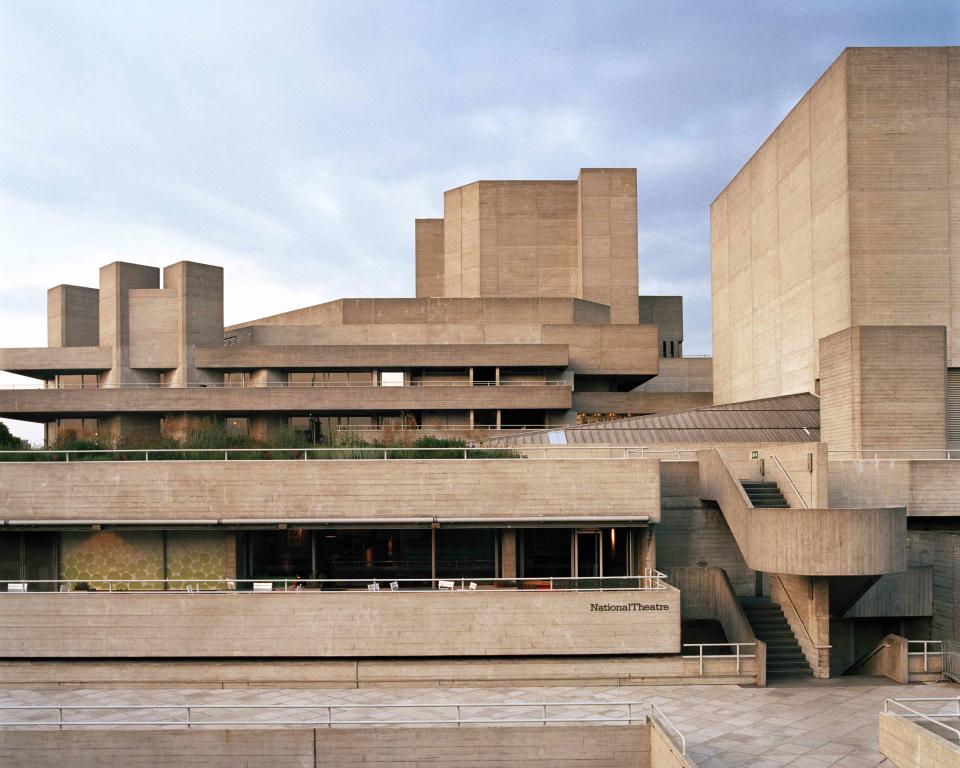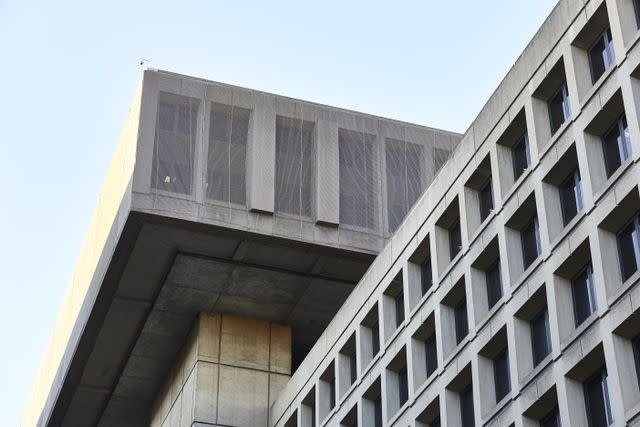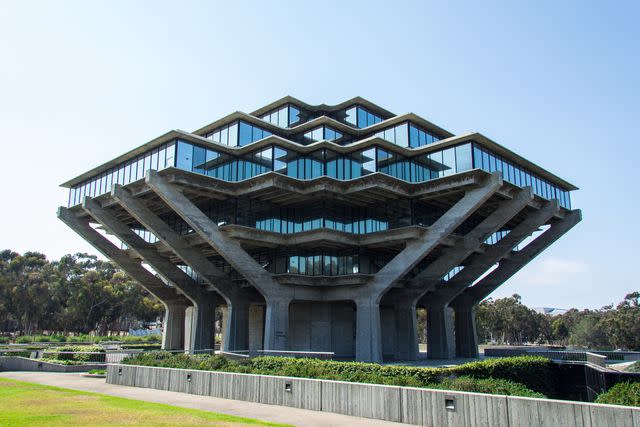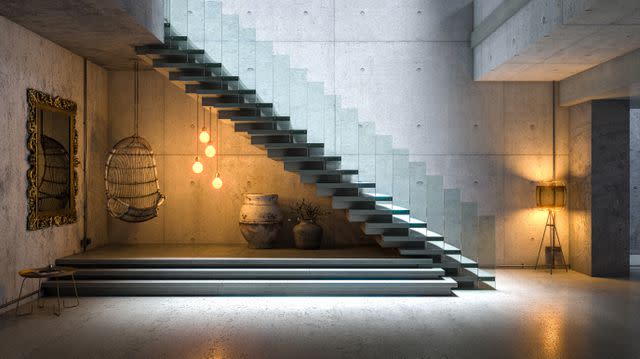What Is Brutalist Architecture? Key Design Elements to Know
It's easily recognized and often maligned, but the heart of Brutalism is honest and simple design.

Getty Images / shomos uddin
In the realm of architectural styles, Brutalism is often cast as a villain. These large, concrete, unadorned structures immediately stand out among other buildings. The Geisel Library at University of California San Diego, by architects William L. Pereira & Associates, and the National Theatre in London, designed by Denys Lasdun, are two iconic examples of Brutalism's rare form.
Brutalism almost appears aggressive, but once you learn more, it’s clear the intention behind the style is far from brutish. “The Brutalist architectural era has been criticized by many for its stark and imposing aesthetic. However, I've always believed that it exemplifies a masterful use of simple geometric forms,” says Will Choui, a contemporary furniture designer working in the Brutalist aesthetic. “To me, Brutalism represents design in its purest form, a movement that deserves appreciation for its candidness and audacity.”

Getty Images / Bjarte Rettedal
History of Brutalist Architecture
The name Brutalism derives from early Brutalist architect Le Corbusier’s use of the French phrase “béton brut,” which refers to the raw or exposed concrete integral to Brutalism. The term Brutalist then developed alongside the architectural style in the UK. “Brutalist architecture is an architectural style that developed in the 1950s in postwar Europe (especially the UK) and became more widespread in the United States in the 1960s,” says Kate Reggev, a New York City-based architect and historian. “Stylistically, it employed a minimalist, modernist approach to design that sought to create functional buildings—often out of concrete—most commonly with simple forms that were 'honest' in the way they expressed their materials and structure."
Cities were growing and rebuilding during this time, which resulted in a surge of practical, efficient Brutalist designs for commercial, civic, and academic buildings. “The emphasis on simplicity and efficiency was essential for creating cost-effective yet sturdy buildings in the post-war era,” says Choui.
Brutalism was popular into the 1970s, but by the 1980s, it was out of style. Because Brutalist buildings were generally urban, they began to be associated with the decay of cities as sites of graffiti and neglect. The concrete structures were also difficult to renovate and prone to water damage and crumbling over time. As an interior style, Brutalism isn’t exactly a timeless decorating style, but it is probably familiar: popular in the 2000s and 2010s, industrial style offers a similar aesthetic.
Despite criticisms, and sometimes even because of them, Brutalism made a lasting impact not only on architectural design but also pop culture. Villains in the James Bond movies, for example, are frequently associated with Brutalist architecture and interiors (the spy's creator, Ian Fleming, even named iconic villain Auric Goldfinger after London’s Brutalist architect Ernő Goldfinger). The campus of Simon Fraser University in British Columbia, a mass of Brutalist structures by architect Arthur Erickson, played the stark and moody set for a number of thrillers and sci-fi films.
In reality, the Brutalist structures have proved burdensome to tear down or alter, so many have remained standing. Ever-growing esteem and affection for Modern Era architecture and design continue to celebrate and protect Brutalist buildings, and their birth out of a need for simple, cost-effective housing resonates today.

Getty Images / Adam Mustafa
Key Features of Brutalism
“Unlike styles that employ superfluous ornamentation to mask their core, in Brutalism, the structure itself becomes the ornament,” says Choui. There’s no more prominent element in Brutalist structures than concrete, whose color and texture is the hallmark of Brutalist design. The cost-efficient material is the basis for the look’s dramatic shapes, varying smooth and rough textures, and slightly drab neutral hues.
“Because of the use of concrete as a primary building material, the proportions for Brutalist designs often resulted in buildings and interiors that were chunky and felt oversized compared to similar buildings or elements constructed out of steel or wood,” says Reggev. Concrete’s liquidity made it highly moldable, allowing building designs to utilize blocky, angular, rounded, and curved shapes, thus making geometry another big piece of the brutalist formula.
Reggev identifies a related characteristic as “repetition of simple forms” and it’s found in both Brutalist interiors and exteriors. “This was often the result of using precast concrete elements, where a single mold was used to create multiples of the same thing, like a window unit,” says Reggev. Built in the 1960s, Marcel Breuer’s corporate office for the Armstrong Rubber Company (now the Hotel Marcel) is quintessentially Brutalist with its tall and highly repetitive exterior. Coffered ceilings found in many Brutalist spaces are a second example.
Choui also identifies “the uncompromising celebration of raw materials and the transparent integrity in its construction” as defining characteristics of Brutalist design. This is a philosophical underpinning with aesthetic impacts. “Many Brutalist interiors lacked interior finishes like drywall, tile, and paint, and just exposed the structure of the building, considering that to be an 'honest' expression,” says Reggev. A central desire for honesty resulted in leaving structural materials like concrete exposed and unadorned. But it also manifested a preference for bringing in natural and authentic elements, rather than materials representing something they're not (Reggev uses faux wood painting as an example).

Getty Images / tiero
Brutalist-Inspired Decor and Design Ideas
“Brutalist design is striking and statement-making—it can be the perfect addition if you are wanting a dose of drama,” says designer Nadia Watts. You don’t need a Brutalist home to capture the style (though it certainly helps). “Brutalist interior design typically followed the same tenets as Brutalist architecture but often scaled down and adapted for interior use,” says Reggev. If you like the look and authenticity behind Brutalist architecture, these tips can help you bring the aesthetic into your own home.
Get the Look of Concrete
“If you're just shooting for the aesthetic, I would say that the use of exposed concrete—whether it is on the floors, walls, or ceiling—would be a big contributor to creating a Brutalist interior,” says Reggev. Concrete is the most authentic way to set the tone for the aesthetic, but it can be a difficult and expensive material to incorporate, as well as a challenge to care for. Stepping aside from Brutalism's honest core, there are a number of concrete-looking materials that can help you achieve the aesthetic in your home. Flooring, ceiling tiles, wallpaper, cladding, and paint colors and applications can be used to achieve that overall concrete look.
Cut Clutter
“To embrace a Brutalist aesthetic, start by decluttering and removing nonessential decor,” says Choui. Gallery walls and meticulously styled shelves of keepsakes are not part of Brutalist interiors. Aim to eliminate clutter, including reducing items in a room and avoiding visual clutter like busy patterns. Stick with closed storage and simple colors and textures. Your spaces should appear neat and tidy.
Create a Minimalist Canvas
“Brutalism focuses on simplicity and function with a lack of ornamentation,” says Watts. Unadorned spaces allow the surface materials or the room’s intentional simplicity to be the star. To set a tone for Brutalism, eliminate finishing elements like millwork and window trimmings and opt for unassuming elements like large, clean-lined windows and open doorways.
Incorporate Texture
“The surface of the concrete was often treated differently to create different textures, ranging from board-formed concrete to exposed aggregate to bush-hammered,” says Reggev. “This attention to detail was in contrast with the large-scale forms of the style, and added a sense of human scale and touch to what was often seen as impersonal, cold, and oversized.” Textures add interest to the minimalist spaces without overstyling or visually complicating a room. In addition to varying smooth and rough applications of concrete or other building materials, incorporating woods, natural fibers, and stone can add texture without straying from the minimalist aesthetic.
Add Geometry Through Furnishings
“Brutalist design often features bold geometric shapes and strong imposing silhouettes,” says Watts. You can use furnishings to achieve drama, even if your home’s structure isn’t sharp and modern. “Prioritize furnishings with clean geometric forms and opt for bold statement pieces that highlight the raw beauty of materials,” says Choui.
Forgo delicately curved legs and ornate details of more traditional styles, and instead opt for strong angles and curves in chunky proportions for furniture and casegoods. An oversize, low-slung sofa can not only reflect the period’s geometry but make a statement, too. Look for handcrafted pieces made from unpainted natural wood, metal, glass, and stone. “The essence of Brutalism lies in its simplicity, boldness, and an honest showcase of construction, so choose elements that align with these principles,” says Choui.
Limit to Neutral Colors
“In terms of color palettes and materials, I'd suggest keeping it simple and erring on the side of neutrals, especially grays,” says Reggev. Grays offer the color of concrete, which is perfect for most surfaces. Additional neutrals can add depth. As for color, Reggev suggests “only one or two very carefully considered pops of color.” Decorative elements should be kept to a minimum, but smaller furnishings are one way to add limited color. Or take inspiration from Brutalist icon Habitat67, Moshe Safdie’s modular housing structure built for the 1967 World Expo in Montreal. Greenery amidst the Brutalist angles softens the austerity, adds a pop of color, and matches the honesty of other incorporated materials.
Opt for Open, Efficient Layouts
“[Brutalist interior design] is closely associated with the Modernist architectural movement, and it often emphasizes functionality and rational design,” says Watts. “This lends towards well laid-out spaces and efficiency.” Open floor plans can help create the large-scale feel of Brutalist architecture. Limit walls and pillars that obstruct views, or ceilings that lower room height. Lay out rooms and floor plans so that they are simple and efficient to use and maneuver.
For more Better Homes & Gardens news, make sure to sign up for our newsletter!
Read the original article on Better Homes & Gardens.

